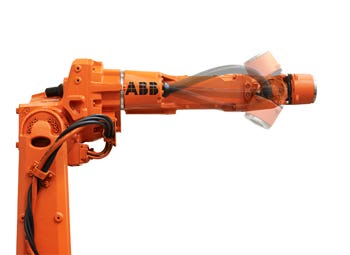Clean cable and hose routing minimizes robot set-up time, maintenance
ABB Robotics (Auburn Hills, MI) has added an Integrated Dress pack (ID) model to its IRB 2600 range of mid-sized material handling robots. The unit features a flexible conduit in its upper arm/wrist for routing cables and hoses for signals, air and power, fully integrating the process equipment with the robot.
February 25, 2011
ABB Robotics (Auburn Hills, MI) has added an Integrated Dress pack (ID) model to its IRB 2600 range of mid-sized material handling robots. The unit features a flexible conduit in its upper arm/wrist for routing cables and hoses for signals, air and power, fully integrating the process equipment with the robot.
ABB Robotics IRB 2600 material-handling robot.
The 1.85-m reach, 15-kg payload IRB 2600ID is specifically designed for a wide range of material handling and machine-tending applications. With the internally routed dress pack, the movement of the hoses and cables is completely predictable, allowing the IRB 2600ID to operate at maximum speeds and simplifying off-line programming. Without needing to account for swinging cables when simulating robot systems, the time required for fine-tuning programs is reportedly minimized by up to 90%.
With the increased payload, including a total upper arm load of 26 kg, the IRB 2600ID is suited for applications including injection molding, machine tools, case packing, carton handling, process tray handling, and small format palletizing. The IRB 2600ID can be mounted in multiple configurations and features a work envelope that extends well below its baseline, making it ideal for machine-mounted applications.
"The emerging trend in industrial robotic design is for process equipment to be fully integrated with the robot, but until now ID robots have been designed only for arc welding," said Joe Campbell, vice president of the ABB Robot Products Group in the US.
Hoses and cables firmly secured and protected inside the robot arm and wrist swing far less during operation, reducing their exposure to sources of wear such as cutting fluids and hydraulic oil. This increases significantly the working life of the cables and hoses, and improves the robot's predictable motion, allowing it to work in narrow spaces and around parts of a complex geometry on which the dressing could otherwise catch. Cable and hose replacement costs are decreased by 75% and up to three production stops per year can be eliminated.-[email protected]
About the Author(s)
You May Also Like


